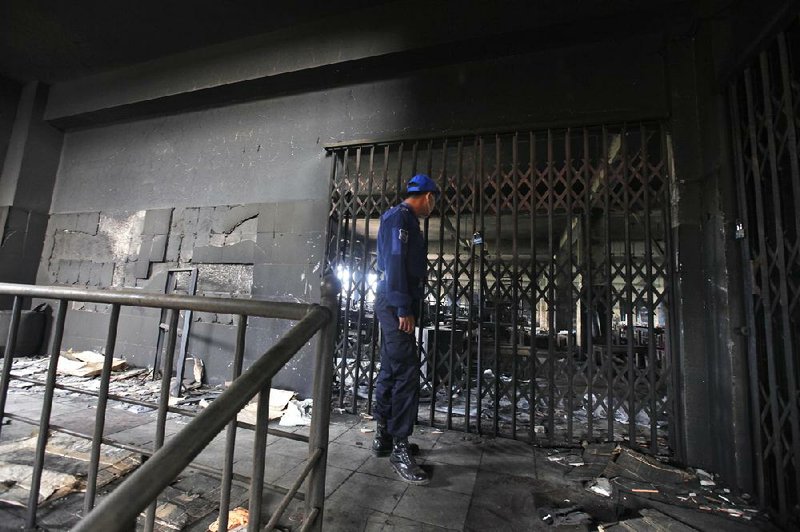DHAKA, Bangladesh — The factory where 112 garment workers died in a fire should have been shut down months ago. The Fire Department refused to renew the certification the factory needed to operate, a top fire official said. And its owner said that just three of the factory’s eight floors were legal. He was building a ninth.
Government officials knew of the problems, but the factory kept running.
The Capital Development Authority could have fined Tazreen Fashions Ltd. or even pushed for the demolition of illegally built parts of the building, said an agency official, who spoke on condition of anonymity. But it chose to do nothing rather than confront one of Bangladesh’s most powerful industries, he said.
“I must say we have our weaknesses. We could not do that,” he said. “Not only Tazreen. There are hundreds more buildings. That’s the truth.”
Bangladesh’s $20 billion-a year garment industry, which accounts for 80 percent of Bangladesh’s total export earnings, goes virtually unchallenged by the government, said Kalpona Akter, executive director of the Bangladesh Center for Worker Solidarity, a labor-rights group.
“These factories should be shut down, but who will do that?” she said. “Any good government inspector who wants to act tough against such rogue factories would be removed from office. Who will take that risk?”
Fire officials did challenge the factory, though they appeared reluctant to go too far.
When the factory’s fire safety certification expired June 30, Dhaka’s fire authorities refused to renew it, a fire official said, speaking on condition of anonymity because he was not authorized to speak to journalists.
A factory must be certified to operate, but the department usually gives factory owners some time to upgrade conditions. If they fail to do so, the department can file a court case to close it down. But it rarely does and did not in Tazreen’s case.
“These factories should be closed, but it is not an easy task,” the fire official said. “We need to follow a protracted legal battle. Always there is pressure because the owners are influential. They can manage everything.”
The Nov. 24 fire tore through the ground floor of the behemoth white concrete factory, which fills most of a block in the Dhaka suburb of Savar. About 1,400 employees were cutting fabric and sewing clothes for Wal-Mart, Disney and other Western brands.
Dipa Akter had no idea she was in any danger during the three years she worked at the Tazreen factory.
“We never thought such a big fire could happen at Tazreen. We thought there would be no problem if there was a fire. There are three stairways ... We never thought our colleagues would die this way,” she said.
Now, the factory stands gutted, its cavernous floors littered with burned clothes, yarn, machinery and furniture. Glass from windows broken by desperate workers who tried to jump to safety is scattered along with black ash on the floors and staircases.
Though the factory had three staircases, it had no specially designed emergency exits. Fire extinguishers in the building either didn’t work or workers didn’t know how to use them, survivors said.
The fire official declined to provide specifics about what violations the department had uncovered in the months before the fire.
“I can’t explain more because the case is very sensitive and this is under investigation,” the official said.
The chairman of the Capital Development Authority, Nurul Huda, did not return calls seeking comment.
Tazreen’s owner, Delwar Hossain, said the government granted him authorization to construct a three-story factory. Nonetheless, he added five more floors and was constructing a ninth when the blaze broke out, he said late Thursday.
The construction is in direct violation of a law that requires advance written approval of factory construction and expansion.
When asked why he went ahead with the expansion anyway, he said: “My mental condition is not good. I am under pressure. Please don’t ask me anything else.”
Hossain is a former accounts manager at a garment factory who started his own company, Tuba Textiles Mills Ltd., in 2004 and now has a dozen factories of his own.
Other factory owners hold parliamentary posts and other prestigious positions. In one sign of the industry’s power, the government has dispatched a special police force to maintain order in the factories.
The risky conditions at the Tazreen plant were known not only to government officials but also to major U.S. retailers whose products were made there.
Wal-Mart audited Tazreenin 2011, giving it an “orange” or high-risk rating. Months later, it did a second audit, and early this year the factory was no longer authorized to produce merchandise for the retail giant. However, an AP reporter who visited the factory last week found Wal-Mart brands were still being made there. The company said a supplier - who has since been fired - had moved Wal-Mart production there without its knowledge.
Akter, the rights activist, estimates that more than half the nation’s more than 4,000 garment factories have safety arrangements only on paper.
Factory owners “are very powerful, or backed by powerful associations and people,” Akter said. She added that many inspectors are bribed to ignore violations.
In the two weeks since the blaze, the Fire Department has inspected 232 factories in the industrial area where Tazreen was located. It found that more than one-quarter of them - 64 - lacked fire-safety licenses or safety measures such as fire extinguishers, water reservoirs and workers trained to fight a fire, said Dhaka Fire Chief M. Abdus Salam.
Those 64 factories, which continue to produce clothes, will be shut down if they fail to address the issues within a month, Salam said.
Front Section, Pages 10 on 12/08/2012
